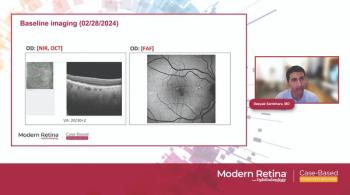
New insights on 'pachychoroid spectrum'
Central serous chorioretinopathy (CSC) is the diagnosis that usually comes to mind when retinal specialists see an eye with choroidal thickening. New insights on choroidal pathology obtained using advanced imaging techniques, however, have led to the description of a broader group of pachychoroid diseases, said K. Bailey Freund, MD, at the inaugural Retina World Congress.
Central serous chorioretinopathy (CSC) is the diagnosis that usually comes to mind when retinal specialists see an eye with choroidal thickening. New insights on choroidal pathology obtained using advanced imaging techniques, however, have led to the description of a broader group of pachychoroid diseases, said K. Bailey Freund, MD, at the inaugural Retina World Congress.
In addition to CSC, this “pachychoroid spectrum” includes pachychoroid pigment epitheliopathy (PPE), focal choroidal excavation (FCE), pachychoroid neovasculopathy (PCN), and polypoidal choroidal vasculopathy (PCV).
Multimodal imaging of pachychoroid pigment epitheliopathy. (Figure courtesy of K. Bailey Freund, MD)
Multimodal imaging of pachychoroid neovasculopathy/polypoidal choroidal vasculopathy. (Figure courtesy of K. Bailey Freund, MD)
kjlkj
“The four newer entities in the pachychoroid spectrum share choroidal features with CSC, but they can look very different in that they can mimic and/or modify the course of age-related macular degeneration (AMD),” said Dr. Freund, clinical professor of ophthalmology, New York University School of Medicine, New York.
“It is important for retinal specialists to be aware of these pachychoroid diseases and to evaluate the choroid carefully using multimodal imaging, particularly when patients are clinically atypical for AMD.”
Defining characteristics
The anatomic features of the pachychoroid phenotype include reduced fundus tessellation in areas of choroidal thickening that is noted clinically or on fundus photography.
In addition, there is a diffuse or focal increase in choroidal thickness and dilated outer choroidal vessels that do not taper within the areas of thickened choroid (“pachyvessels”) seen with en face swept-source optical coherence tomography (OCT); and attenuation and thinning of the choriocapillaris and Sattler’s layer vessels overlying the pachyvessels visualized on enhanced depth imaging OCT or swept-source OCT. Indocyanine green (ICG) angiography will show mid-phase choroidal hypermeability (staining of the choroidal stroma).
“Although the term pachychoroid describes a thickened choroid, it is important to note that the thickening is associated with the development of large dilated vessels while these patients are losing some of the inner choroid that provides nutritional support to the overlying retina,” Dr. Freund said.
PPE, CSC, and FCE can manifest early in adulthood. PPE, which can be considered a forme fruste of CSC, and FCE are characterized by focal RPE changes in the macula within areas of thickened choroid. In contrast to CSC, subretinal fluid is absent in PPE.
Dr. Freund noted that PPE is a very common incidental finding and often misdiagnosed.
“I see several new patients with PPE every week in clinical practice,” he said.
“It is often mistaken for early AMD, atypical pattern dystrophy, punctate inner choroidopathy, or retinal pigment epitheliitis," he said. "Reduced fundus tessellation is a clue to the diagnosis of PPE, and patients will also be atypically young for AMD and lack drusen. Multimodal imaging is needed, however, to definitively differentiate PPE from the other disorders.”
Accurate diagnosis of PPE is important to avoid unnecessary treatment. Dr. Freund said the prognosis for PPE is generally very good as the fundus findings may remain unchanged for years.
Over time, however, eyes with PPE as well as those with CSC can develop choroidal neovascularization. The neovascularization (NV) is often an indolent form of a type 1 (sub-RPE) lesion. On structural OCT, the vascular network will appear as a shallow irregular RPE elevation with or without overlying subretinal fluid. The best way to identify the type 1 neovessels themselves is with OCT angiography.
“Fluorescein and ICG angiography can be difficult to interpret,” Dr. Freund said.
Eyes are categorized as having PCN if they have type 1 NV with pachychoroid features and no history of CSC. In some eyes with PNV, polyps will form from the neovessels, leading to the development of PCV. Dr. Freund noted that if one considers PCV a form of PCN, about 50% of eyes diagnosed with neovascular AMD in Asia and about 15% of those presenting to his practice with neovascular AMD actually have PCN.
In contrast to patients with true neovascular AMD, those with PCN and PCV tend to be younger, lack drusen, rarely develop macular atrophy, and often need more anti-VEGF injections. According to findings of a recently published study, patients with PCN do seem to carry the risk alleles that predispose to neovascular AMD (ARMS2 and CFH).
“Historically, many people have thought of PCV as a discrete entity and believe that the polyps originate directly from the choroid," Dr. Freund said. "We now know, however, that the polyps originate from the neovascular tissue, and the neovascularization can be undetected for years as it grows slowly without leakage.”
Dr. Freund is an advisor to Heidelberg Engineering, Optos, and Optovue.
Newsletter
Keep your retina practice on the forefront—subscribe for expert analysis and emerging trends in retinal disease management.








































